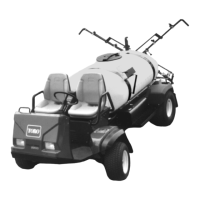34
COOLING SYSTEM MAINTENANCE
CAUTION
Coolant in a hot radiator is under extreme
pressure. Scalding hot coolant or steam
can blow out of the radiator, causing
serious injury.
Never remove the radiator cap, under any
conditions, when the engine is running.
Never remove the radiator cap when the
engine or radiator are hot.
IMPORTANT! NEVER SPRAY WATER ONTO A
HOT ENGINE AS DAMAGE MAY OCCUR.
IMPORTANT! NEVER ADD COOLANT TO AN
ENGINE THAT HAS BECOME OVERHEATED,
UNTIL THE ENGINE HAS COOLED. ADDING
COOLANT TO AN EXTREMELY HOT ENGINE
CAN RESULT IN A CRACKED BLOCK OR
CYLINDER HEAD.
Whenever coolant level checks are made check
condition of the rubber seal on the Radiator Cap.
Make sure the Radiator Filler Neck and Cap are
clean and rinsed free of any dirt particles.
The cooling system has a total capacity of 12
quarts (11.5 liters). A 50/50 mix of anti- freeze and
clean water is recommended.
Maintain the coolant level at approximately 3/4 to
1-1/2 inches below the Filler Neck seat on the
Radiator when the coolant is cold.
Remove debris from engine area, oil cooler, and
radiator daily, clean more frequently in dirty
conditions.
CHANGING ENGINE COOLANT
(Fig. 31)
1. Park vehicle on level surface.
2. Remove radiator cap (ONLY IF IT IS COOL
TO THE TOUCH!)
If engine has been running, pressurized
hot coolant can escape and cause burns
if cap is removed.
Before removing cap, allow engine to
cool for at least 15 minutes or until the
cap is not hot to the touch.
CAUTION
3. Open coolant drain cock at bottom of radiator
and allow coolant to flow into drain pan. When
coolant stops, close drain cock. (Fig. 31)
4. Slowly fill radiator with a 50/50 mixture of water
and recommended coolant. Install the radiator
cap securely.
5. Start engine and operate until warm. Recheck
level and replenish, if required.
Use only a permanent-type coolant that meets
Ford Specification ESE-M97B44-A. Refer to the
coolant mixture chart on the container for
additional antifreeze protection information. Do
not use alcohol or methanol antifreeze.
Every 200 hours (more often in dusty areas)
inspect the exterior of the radiator and oil cooler
for obstructions. Remove all bugs, dirt, or foreign
material with a soft brush or cloth. Use care to
avoid damaging the fins. If available, use low
pressure compressed air or a stream of water in
the opposite direction of normal air flow.
Check all hoses and connections for leaks. If any
of the hoses are cracked, frayed, or feel spongy,
they should be replaced.
Figure 31
1. Radiator Drain Cock

